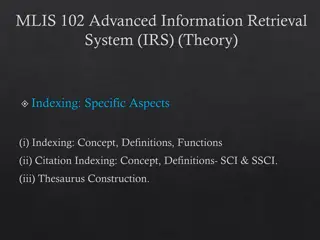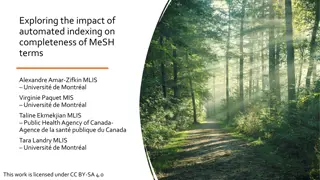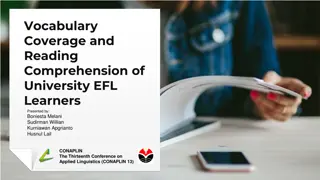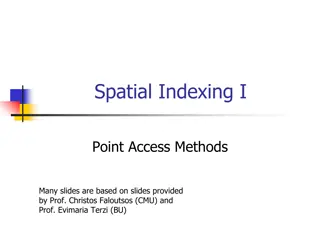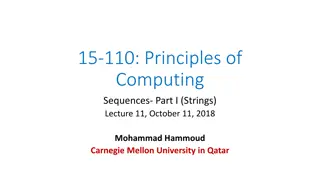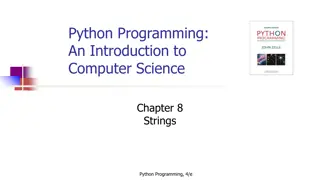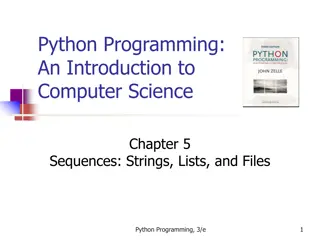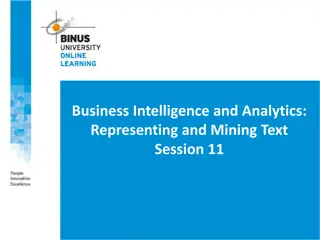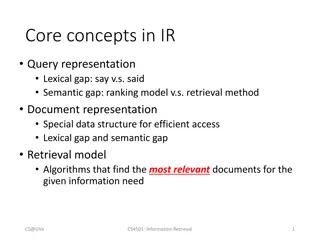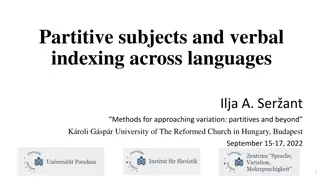Text Processing: Indexing, Zipf's Law, and Vocabulary Growth
Processing text involves converting documents into index terms, addressing issues like word variations, indexing text and metadata, understanding word frequency distribution with Zipf's Law, and predicting vocabulary growth with Heaps' Law.
Download Presentation

Please find below an Image/Link to download the presentation.
The content on the website is provided AS IS for your information and personal use only. It may not be sold, licensed, or shared on other websites without obtaining consent from the author.If you encounter any issues during the download, it is possible that the publisher has removed the file from their server.
You are allowed to download the files provided on this website for personal or commercial use, subject to the condition that they are used lawfully. All files are the property of their respective owners.
The content on the website is provided AS IS for your information and personal use only. It may not be sold, licensed, or shared on other websites without obtaining consent from the author.
E N D
Presentation Transcript
Chapter 4 Processing Text
Processing Text Modifying/Converting documents to index terms Convert the many forms of words into more consistent index terms that represent the content of a document What are the problems? Matching the exact string of characters typed by the user is too restrictive, e.g., case-sensitivity, punctuation, stemming it doesn t work very well in terms of effectiveness Sometimes not clear where words begin and end Not even clear what a word is in some languages, e.g., in Chinese and Korean Not all words are of equal value in a search, and understanding the statistical nature of text is critical 2
Indexing Process Text + Meta data (Doc type, structure, features, size, etc.) Takes index terms and creates data structures (indexes) to support fast searching Identifies and stores documents for indexing Transforms documents into index terms or features or Text Processing 3
Zipfs Law Distribution of word frequencies is very skewed Few words occur very often, many hardly ever occur e.g., the and of , two common words, make up about 10% of all word occurrences in text documents Zipf s law: The frequency f of a word in a corpus is inversely proportional to its rank r (assuming words are ranked in order of decreasing frequency) f = k f r = k r where k is a constant for the corpus 4
Zipfs Law Example. Zipf s law for AP89 with problems at high and low frequencies According to [Ha 02], Zipf s law does not hold for rank > 5,000 is valid when considering single words as well as n-gram phrases, combined in a single curve. [Ha 02] Ha et al. Extension of Zipf's Law to Words and Phrases. In Proc. of Int. Conf. on Computational Linguistics. 2002. 6
Vocabulary Growth Heaps Law, another prediction of word occurrence As corpus grows, so does vocabulary size. However, fewer new words when corpus is already large Observed relationship (Heaps Law): v = k n where v is the vocabulary size (number of unique words) n is the totalnumber of words in corpus k, are parameters that vary for each corpus (typical values given are 10 k 100and 0.5) Predicting that the number of new words increases very rapidly when the corpus is small 7
AP89 Example (40 million words) ( ) (k) v = k n 8
Heaps Law Predictions Number of new words increases very rapidly when the corpus is small, and continue to increase indefinitely Predictions for TREC collections are accurate for large numbers of words, e.g., First 10,879,522 words of the AP89 collection scanned Prediction is 100,151 unique words Actual number is 100,024 Predictions for small numbers of words (i.e., < 1000) are much worse 9
Heaps Law on the Web Heaps Law works with very large corpora New words occurring even after seeing 30 million! Parameter values different than typical TREC values New words come from a variety of sources Spelling errors, invented words (e.g., product, company names), code, other languages, email addresses, etc. Search engines must deal with these large and growingvocabularies 10
Heaps Law vs. Zipfs Law As stated in [French 02]: The observed vocabulary growth has a positive correlation with Heaps law Zipf s law, on the other hand, is a poor predictor of high- ranked terms, i.e., Zipf s law is adequate for predicting medium to low ranked terms While Heaps law is a valid model for vocabulary growth of web data, Zipf slaw is not strongly correlated with web data [French 02] J. French. Modeling Web Data. In Proc. of Joint Conf. on Digital Libraries (JCDL). 2002. 11
Estimating Result Set Size Word occurrence statistics can be used to estimate the size of the results from a web search How many pages (in the results) contain all of the query terms (based on word occurrence statistics)? Example. For the query a b c : fabc= N fa/N fb/N fc/N = (fa fb fc)/N2 fabc: estimated size of the result setusing joint probability fa, fb, fc: the number of documents that terms a, b, and c occur in, respectively N is the total number of documents in the collection Assuming that terms occur independently 12
TREC GOV2 Example Poor Estimation Due to the Independent Assumption Collection size (N) is 25,205,179 13
Result Set Size Estimation Poor estimates because words are not independent Better estimates possible if co-occurrence info. available P(a b c) = P(a b) P(c | a b) = P(a b) (P(b c) / P(b)) (c) (b) (a) f tropical aquarium fish = f tropical aquarium f aquarium fish / f aquarium = 1921 9722 / 26480 = 705 (1,529, actual) f tropical breeding fish = f tropical breeding f breeding fish / f breeding = 5510 36427 / 81885 = 2,451 (3,629 actual) 14
Result Set Estimation Even better estimates using initial result set (word frequency + current result set) Estimate is simply C/s where s is the proportion of the total number of documents that have been ranked (i.e., processed) & C is the number of documents found that contain all the query words Example. tropical fish aquarium in GOV2 After processing 3,000 out of the 26,480 documents that contain aquarium , C = 258 11% f tropical fish aquarium = 258 / (3000 26480) = 2,277 (> 1,529) After processing 20% of the documents, f tropical fish aquarium = 1,778 (1,529 is real value) where C = 356 & 5,296 documents have been ranked 15
Tokenizing Problems Small words can be important in some queries, usually in combinations xp, bi, pm, cm, elpaso, kg, beneking, masterp, worldwar II Both hyphenated and non-hyphenated forms of many words are common Sometimes hyphen is not needed e-bay, wal-mart, active-x, cd-rom, t-shirts At other times, hyphens should be considered either as part of the word or a word separator winston-salem, mazda rx-7, e-cards, pre-diabetes, t-mobile, spanish-speaking 16
Tokenizing Problems Special characters are an important part of tags, URLs, code in documents Capitalized words can have different meaning from lower case words Bush, Apple, House, Senior, Time, Key Apostrophes can be a part of a word/possessive, or just a mistake rosie o'donnell, can't, don't, 80's, 1890's, men's straw hats, master's degree, england's ten largest cities, shriner's 17
Tokenizing Problems Numbers can be important, including decimals Nokia 3250, top 10 courses, united 93, quicktime 6.5 pro, 92.3 the beat, 288358 Periods can occur in numbers, abbreviations, URLs, ends of sentences, and other situations I.B.M., Ph.D., cs.umass.edu, F.E.A.R. Note: tokenizing steps for queries must be identical to steps for documents 18
Tokenizing Process Not that different than simple tokenizing process used in the past Examples of rules used with TREC Apostrophes in words ignored o connor oconnor bob s bobs Periods in abbreviations ignored I.B.M. ibm Ph.D. phd 19
Stopping Function words (conjunctions, prepositions, articles) have little meaning on their own High occurrence frequencies Treated as stopwords(i.e., text processing stops when words are detected & removed hereafter) Reduce index space Increase efficiency (i.e., response time) Improve effectiveness Can be important in combinations e.g., to be or not to be 20
Stopping Stopword list can be created from high-frequency words or based on a standard list Lists are customized for applications, domains, and even parts of documents e.g., click is a good stopword for anchor text 21
Stemming Many morphological variations of words to convey a single idea Inflectional (plurals, tenses) Derivational (making verbs into nouns, etc.) In most cases, these have the same or very similar meanings Stemmers attempt to reduce morphological variations of words to a common stem Usually involves removing suffixes Can be done at indexing time/as part of query processing (like stopwords) 22
Stemming Two basic types Dictionary-based: uses lists of related words Algorithmic: uses program to determine related words Algorithmic stemmers Suffix-s: remove s endings assuming plural e.g., cats cat, lakes lake, wiis wii Some false positives: ups up (find a relationship when none exists) Many false negatives: countries countrie (Fail to find term relationship) 23
Porter Stemmer Algorithmic stemmer used in IR experiments since the 70 s Consists of a series of rules designed to extract the longest possible suffix at each step, e.g., - Delete s if the preceding word contains a vowel not immediately before s (e.g., gaps gap, gas gas) - Replace ied or ies by i if preceded by > 1 letter; o.w., by ie (e.g., ties tie, cries cri) Step 1a: - Replace sses by ss (e.g., stresses stress) Effective in TREC Produces stems not words Makes a number of errors and difficult to modify 24
Errors of Porter Stemmer It is difficult to capture all the subtleties of a language in a simple algorithm { No Relationship } { Fail to Find a Relationship } Porter2 stemmer addresses some of these issues Approach has been used with other languages 25
Link Analysis Links are a key component of the Web Important for navigation, but also for search e.g., <a href="http://example.com">Example website</a> Example website is the anchor text http://example.com is the destination link both are used by search engines 26
Anchor Text Describe the content of the destination page i.e., collection of anchor text in all links pointing to a page used as an additional text field Anchor text tends to be short, descriptive, and similar to query text Retrieval experiments have shown that anchor text has significant impact on effectiveness for some types of queries i.e., more than PageRank 27
PageRank Billions of web pages, some more informative than others Links can be viewed as information about the popularity (authority?) of a web page Can be used by rankingalgorithms Inlinkcount could be used as simple measure Link analysis algorithms like PageRank provide more reliable ratings, but less susceptible to link spam PageRank of a page is the probabilitythat the random surfer will be looking at that page Links from popular pages increase PageRank of pages they point to, i.e., links tend to point to popular pages 28
PageRank PageRank (PR) of page C = PR(A)/2 + PR(B)/1 More generally where u is a web page Bu is the set of pages that point to u Lv is the number of outgoing links from page v (not counting duplicate links) 29
PageRank Don t know PageRankvalues at start Example. Assume equal values of 1/3, then 1st iteration: PR(C) = 0.33/2 + 0.33/1 = 0.5 PR(A) = 0.33/1 = 0.33 PR(B) = 0.33/2 = 0.17 2nd iteration: PR(C) = 0.33/2 + 0.17/1 = 0.33 PR(A) = 0.5/1 = 0.5 PR(B) = 0.33/2 = 0.17 3rd iteration: PR(C) = 0.5/2 + 0.17/1 = 0.42 PR(A) = 0.33/1 = 0.33 PR(B) = 0.5/2 = 0.25 Converges to PR(C) = 0.4 PR(A) = 0.4 PR(B) = 0.2 30


